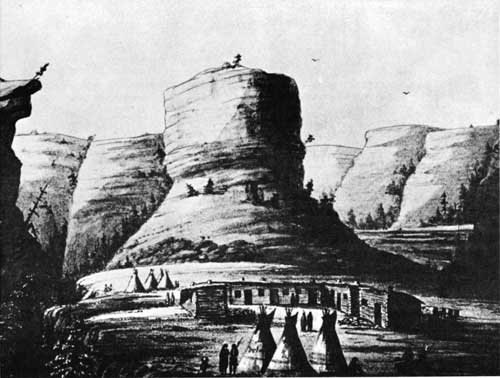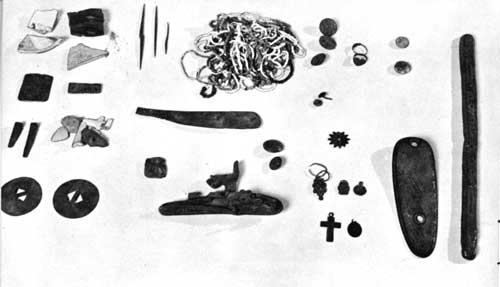|
SCOTTS BLUFF National Monument |
 |

Robidoux's second trading post at "Scott's Bluffs".
Sketch by Möllhausen, 1851.
Gold Rush Trading Posts at Scotts Bluff
The big climax years for Robidoux Pass were 1849-51. A surprisingly large number of emigrant journals for these years have survived and most of them devote a lot of attention to (1) the magnificent scenery of Scotts Bluff, (2) the unusually fine springs and ample firewood here, (3) the view from the crest of the pass toward Laramie Peak (then sometimes called "the Black Hills," and frequently mistaken for the Rocky Mountains), and (4) Robidoux's log cabin blacksmith shop and trading post, and its colorful inhabitants.
Again, recent research, involving journals, Government records, and interviews with Indian descendants, has uncovered facts concerning the Robidoux establishment which have long been wrapped in obscurity. In 1849 emigrant J. Goldsborough Bruff noted "a cool clear spring and brook" in the deep gulch around which the wagons had to detour. "Close by is a group of Indian lodges and tents, surrounding a log cabin, where you can buy whisky for $5 per gallon; and look at the beautiful squaws, of the traders."
Another illuminating description is that given by Captain Stansbury on his westward trip of 1849:
. . . Three miles from the Chimney Rock, the road gradually leaves the river for the purpose of passing behind Scott's Bluff, a point where a spur from the main ridge comes so close to the river as to leave no room for the passage of teams. There was no water between these two points, a distance of more than twenty miles, and we were consequently obliged to go on until nine o'clock, when we encamped at the bluff, on a small run near a delicious spring, after having been in the saddle sixteen hours without food, and travelled thirty-one and a-half miles. The march was a severe one upon the animals, as they were in harness, after the noon halt, for seven successive hours, without water. The afternoon was oppressively hot, and the gnats and musquitoes almost insufferable. There is a temporary blacksmith's shop here, established for the benefit of the emigrants, but especially for that of the owner, who lives in an Indian lodge, and had erected a log shanty by the roadside, in one end of which was the blacksmith's forge, and in the other a grog-shop and sort of grocery. The stock of this establishment consisted principally of such articles as the owner had purchased from the emigrants at a great sacrifice and sold to others at as great a profit. Among other things, an excellent double wagon was pointed out to me, which he had purchased for seventy-five cents. The blacksmith's shop was an equally profitable concern; as, when the smith was indisposed to work himself, he rented the use of shop and tools for the modest price of seventy-five cents an hour, and it was not until after waiting for several hours that I could get the privilege of shoeing two of the horses, even at that price, the forge having been in constant use by the emigrants. Scott's Bluff according to our measurement, is five hundred and ninety-six miles from Fort Leavenworth, two hundred and eighty-five from Fort Kearny, and fifty-one from Fort Laramie.
Others wryly note the shrewdness of this makeshift proprietor, Robidoux. Various journalists refer to two or more "Frenchmen" and their squaws, and an indefinite number of children. In 1850 James Bennett found here "an encampment of near a 100 Sioux Indians" (relatives, no doubt!). In 1851 Father De Smet returning from the Horse Creek Treaty Council, baptized Robidoux's half-breed children.
In 1851, Robidoux, feeling somewhat overrun by the emigrant hordes, retired to a secluded canyon about a mile southeast of the original location. The appearance of this second trading post has been providentially preserved in a sketch by the German traveler, Frederick Möllhausen. The site of this post has been identified in present Carter Canyon.

Historical objects from site of Robidoux's trading post.
Collection in Oregon Trail Museum.
Who was Robidoux? Although all the facts are not fully established, it appears that he was Joseph E. Robidoux, oldest son of the Joseph Robidoux who founded St. Joseph, Mo.; and that the other "Frenchman" seen there was his uncle, Antoine Robidoux, who earlier achieved pioneering fame in Utah and California. The younger Joseph is an elusive figure. He may well have been the Robidoux who led the first American Fur Company contingent by Scotts Bluff in 1830, and who was seen at Fort Laramie in 1846 by Parkman.
What became of Robidoux? Although reported to have died accidentally at Scotts Bluff, no grave has been identified. There is evidence that he returned to the Great Nemaha Indian Agency, in northeastern Kansas, in the late fifties, and died there in obscurity. There are many half-breed "Robidouxes" on Indian reservations in South Dakota who have identified the Scotts Bluff Robidoux as their ancestor.
Modern research has revealed another fact long lost sight of. Robidoux's trading post was not the only one in this neighborhood during the gold rush. It has now been definitely established that, in the summer of 1849, after they sold adobe-walled Fort John (Fort Laramie) to the U. S. Government officials of the American Fur Company removed to Scotts Bluff. Contrary to a long-held erroneous impression, their new post was not located near Mitchell Pass (there never was a trading post near there); it was first located tentatively in Robidoux Pass, within a few hundred yards of Robidoux's blacksmith shop. Then, for reasons which can only be surmised, it was moved to a point 6 miles below Robidoux's and 8 miles south of Mitchell Pass, in present Helvas Canyon. In correspondence of the fur company it was identified as "Fort John, Scott's Bluffs."
This post, being off the main trail, did not rate much notice by travelers, compared with the attention given to Robidoux, but there are occasional references. In 1850 James Bennett states that about 7 miles below Robidoux's there was a trading post "3 miles to our left, where we could see a herd of cattle grazing." Sgt. Percival G. Lowe of the Dragoons, in 1850, reports that "we turned south and camped near a trading post belonging to Major Dripps."
Andrew Drips, the "mountain man" who had guided De Smet up this way in 1840, was later replaced by Joseph Papin of St. Louis, who died and was buried here. His grave and the outlines of the second "Fort John" have been identified. It is not known just when this place was abandoned. However, when the main artery of traffic definitely moved from Robidoux to Mitchell Pass, in 1852, "Fort John" and Robidoux's post both doubtless "withered on the vine," in the manner of a modern-day filling station which is by-passed by a new highway.
Collections of historical objects found on the surface of the sites of Robidoux's two posts and "Fort John, Scott's Bluffs" are preserved in the Oregon Trail Museum. Beads, pendants, danglers, belts, buttons, medallions, coins, traps, bar lead, bullet molds, and other objects testify to the variety of activities conducted at these stations. Although long consigned to oblivion, these primitive commercial establishments were the true beginnings of private enterprise in the Scotts Bluff area.

|

|
|
Last Modified: Sat, Dec 9 2000 10:00:00 am PDT |


